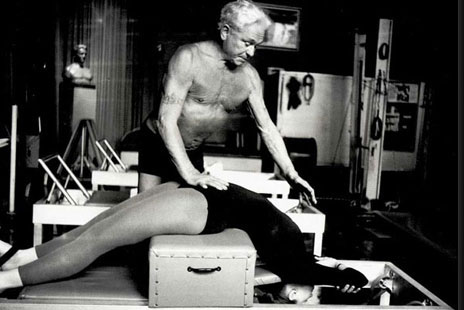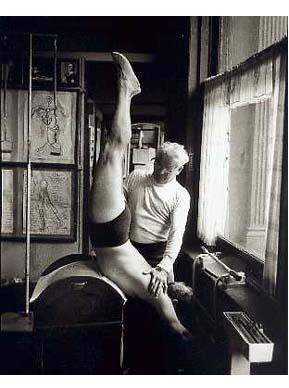History Of Joseph Pilates
 Joseph Humbertus Pilates was a man who believed completely in his method and practiced what he prescribed to others well into his eighties. Even as an older man he was quite robust and vital until his death, at the age of 87. His death was due to smoke inhalation from a fire in a restaurant below his studio on 8th Avenue in New York City.
Joseph Humbertus Pilates was a man who believed completely in his method and practiced what he prescribed to others well into his eighties. Even as an older man he was quite robust and vital until his death, at the age of 87. His death was due to smoke inhalation from a fire in a restaurant below his studio on 8th Avenue in New York City.
In 1880 near Dusseldorf Germany, Joseph Pilates was born to a prize-winning gymnast father and a mother who subscribed to naturopath forms of healing. His unusual name is actually derived from his Greek heritage and would have been spelled “Pilatos.” Some controversy surrounds the correct pronunciation of his name. Nearly all publications phonetically spell it (Pi-LAH-teez), however, according to Joseph’s niece, Mary Pilates LaRiche, she recalls it as pronounced (Pi-LOTTS).
As a child, Joseph suffered from several health ailments: asthma, rickets, and rheumatic fever. In an effort to restore his own health, he studied anatomy books and reinforced what he learned by observing animals in the woods. “Take a horse,” he later said in discussing body conditioning, “If a man wants to race him, he keeps him in top form. He makes the horse move. Why not keep humans in top form too?” Joseph studied Eastern disciplines, like yoga and martial arts, and blended them with more Western forms of physical activities, such as bodybuilding, gymnastics, boxing and recreational sports; even incorporating ancient Greek and Roman forms of fitness practices. By the age of fourteen he had sculpted his physique to such an extent that he was posing for anatomical charts.
 As a young man, Joseph boxed, and taught self-defense. In 1912 he moved to England where he continued to box and taught self-defense at police schools and Scotland Yard. He also performed a Greek statue act in the circus with his brother to earn money. When Britain entered World War I, his German citizenship led to his imprisonment along with other German nationals as “enemy aliens.” Despite the unfortunate circumstances, this was a fundamental time in the development of his method. Photojournalist I.C. Rapoport, who interviewed Joseph in 1961, documents that Joseph said he observed animals in the camp stretching and incorporated this into the foundation of his matwork. During his imprisonment Joseph taught his exercises to fellow compatriots, and later he acted as a nurse-physiotherapist of sorts. Here he developed the first concepts for his innovative machines by disassembling the camp bunk beds and using the springs as a form of resistance to rehabilitate the injured and bed-ridden. One of the greatest examples of the immense benefits of practicing Joseph Pilates’ holistic approach to health is the outbreak of a terrible influenza in 1918. The 1918 influenza epidemic decimated populations all over the world; areas of close co-habitations of people, such as internment camps, were especially hard hit. However, all those who followed Joseph’s routine survived due to their good health.After the war Joseph returned to Germany. He continued training police officers in Hamburg and also worked with dance and movement experts. When he was pressured to train the New German Army, Joseph chose to leave Germany. He immigrated to New York, and on the boat met Clara, a nurse. The two married and founded a studio that taught his developing method, “Contrology.”
As a young man, Joseph boxed, and taught self-defense. In 1912 he moved to England where he continued to box and taught self-defense at police schools and Scotland Yard. He also performed a Greek statue act in the circus with his brother to earn money. When Britain entered World War I, his German citizenship led to his imprisonment along with other German nationals as “enemy aliens.” Despite the unfortunate circumstances, this was a fundamental time in the development of his method. Photojournalist I.C. Rapoport, who interviewed Joseph in 1961, documents that Joseph said he observed animals in the camp stretching and incorporated this into the foundation of his matwork. During his imprisonment Joseph taught his exercises to fellow compatriots, and later he acted as a nurse-physiotherapist of sorts. Here he developed the first concepts for his innovative machines by disassembling the camp bunk beds and using the springs as a form of resistance to rehabilitate the injured and bed-ridden. One of the greatest examples of the immense benefits of practicing Joseph Pilates’ holistic approach to health is the outbreak of a terrible influenza in 1918. The 1918 influenza epidemic decimated populations all over the world; areas of close co-habitations of people, such as internment camps, were especially hard hit. However, all those who followed Joseph’s routine survived due to their good health.After the war Joseph returned to Germany. He continued training police officers in Hamburg and also worked with dance and movement experts. When he was pressured to train the New German Army, Joseph chose to leave Germany. He immigrated to New York, and on the boat met Clara, a nurse. The two married and founded a studio that taught his developing method, “Contrology.”
Joseph and Clara taught their method of using the mind to control the muscles to a devout following in New York. Local dancers came regularly to heal injuries quickly and improve their strength while maintaining their flexibility. George Balanchine and Martha Graham became devotees to Joseph Pilates’ method and often sent their dance students to “Uncle Joe,” as some called him affectionately. Joseph also taught his mat work at Jacob’s Pillow in the summer to young dancers in Becket, Massachusetts. His hour-long classes began with deep breathing–a fundamental element of the Pilates method.
